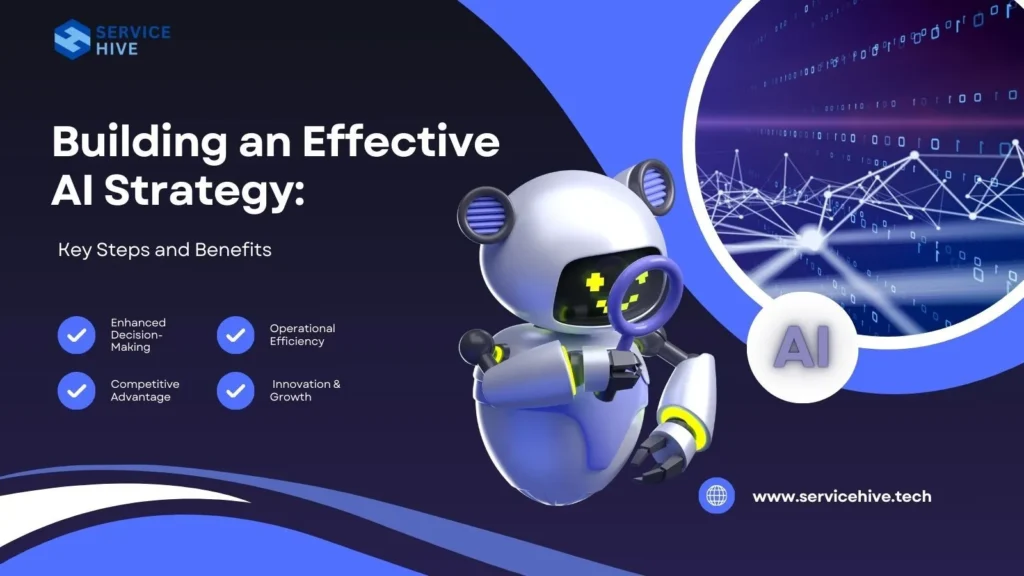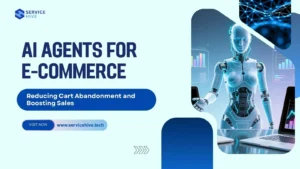Building an Effective AI Strategy: Key Steps and Benefits

In today’s rapidly evolving digital landscape, businesses are increasingly looking toward artificial intelligence (AI) to gain a competitive edge. However, adopting AI is not as simple as implementing a single tool or software. Companies need a well-thought-out AI strategy to ensure successful integration, measurable outcomes, and long-term value.
This blog explores why an AI strategy is essential, the steps to develop one, and the benefits it brings to organizations.
Why You Need an AI Strategy
An AI strategy acts as a roadmap that guides your company through AI integration. Without it, AI initiatives risk being fragmented, ineffective, or misaligned with business goals.
A strong AI strategy helps businesses answer critical questions such as:
- Which AI tools or platforms should we use—on-premise or cloud-based?
- Should we build an in-house AI team or work with external consultants?
- Which business processes can benefit most from AI integration?
- How can AI enhance core competencies and provide competitive advantages?
- What partnerships or collaborations are necessary for AI success?
By addressing these questions early, companies can make informed decisions that balance cost, risk, and performance.
Key Steps to Develop an AI Strategy
- Assess Business Goals and AI Opportunities
Start by identifying areas where AI can add value. Focus on processes that are repetitive, data-intensive, or have high-impact decision-making potential. Consider both short-term wins and long-term capabilities.
- Decide Between Cloud or On-Premise Solutions
Choosing between a cloud-based AI service and an on-premise AI hub depends on factors like cost, scalability, data security, and internal expertise. Cloud solutions offer flexibility and lower upfront costs, while on-premise setups give greater control over data.
- Build the Right AI Team
Determine whether to hire in-house AI talent or collaborate with consultants. Consultants can accelerate knowledge transfer and help implement AI best practices while your team gains hands-on experience.
- Select Processes for AI Integration
Identify business processes where AI can create maximum impact with minimal risk. Prioritize areas that enhance efficiency, reduce errors, or provide unique insights. Implementing AI in core competencies first can reduce risks and pave the way for broader adoption.
- Evaluate Tools and Third-Party Services
Choose tools and platforms that align with your business needs. While major cloud providers offer robust AI solutions, third-party tools may be needed to supplement gaps or fix specific issues. Consistency in platform usage is critical to avoid fragmentation.
- Consider Organizational and Partnership Implications
AI adoption may change expectations for internal teams and external partners. Determine whether existing partners can support AI initiatives or if new partnerships are necessary to access cutting-edge capabilities.
- Create a Strategic Roadmap
Once decisions are made, document the AI strategy as a living guide. It is flexible, allowing the framework to evolve as technology and business needs change. An effective AI adoption strategy ensures all teams and tools align, reducing friction during implementation.
Benefits of an AI Strategy
- Aligned Business Goals – Ensures AI projects support company objectives, reducing wasted effort.
- Reduced Risk – Identifies potential challenges and mitigates them before large-scale implementation.
- Faster Adoption – Streamlines decision-making and accelerates deployment of AI integration.
- Optimized Investment – Guides resource allocation to the most impactful areas.
- Enhanced Competitiveness – Supports AI-driven business decisions to improve efficiency, customer experience, and innovation.
Future Trends in AI Strategy
- AI-Driven Decision Making – Using predictive analytics to forecast sales trends or customer behavior.
- Integrated AI Ecosystems – Linking CRM, ERP, and analytics platforms for seamless AI insights.
- Automation at Scale – Expanding AI from pilot projects to organization-wide processes, such as automated reporting or intelligent customer support.
- Ethical AI and Governance – Ensuring AI systems comply with regulatory standards and ethical guidelines, for instance in data privacy or fairness.
These trends demonstrate how AI strategy evolves beyond technology to impact decisions, operations, and long-term planning.
Final Thoughts
A successful AI journey begins with a clear AI strategy. By making informed decisions about tools, teams, processes, and partnerships, companies can implement AI effectively, reduce risks, and unlock measurable business value.
Looking to develop an AI strategy for your organization? Connect with Service Hive to create tailored AI solutions that drive results.
FAQs
Q1. What is an AI strategy?
An AI strategy is a structured plan that outlines how a company will adopt and implement AI technologies to achieve business goals.
Q2. Why is an AI roadmap important?
A roadmap provides a step-by-step guide for AI adoption, helping companies prioritize projects, allocate resources, and reduce risks.
Q3. Should a company hire AI experts or use consultants?
Both options are valid. Consultants can accelerate implementation and knowledge transfer, while in-house experts ensure long-term sustainability.
Q4. How do I choose between cloud and on-premise AI solutions?
Consider cost, scalability, data security, and internal expertise. Cloud is flexible and cost-effective, while on-premise offers more control.
Q5. What are the key benefits of an AI strategy?
An AI strategy ensures alignment with business goals, reduces risk, accelerates adoption, optimizes investment, and enables AI-driven business decisions.

Why E-Commerce Brands Partner with Service Hive for AI-Powered Growth
Why E-Commerce Brands Partner with Service Hive for AI-Powered Growth Adopting AI inside a business often feels exciting and intimidating

Service Hive’s AI Marketing Solutions for Online Brands
Service Hive’s AI Marketing Solutions for Online Brands Marketing used to be about creativity and timing. Today, it’s also about

Customer Behaviour Analytics: Turning Browsers into Buyers
Customer Behaviour Analytics: Turning Browsers into Buyers Customers browse, pause, scroll, compare — and then disappear. Not because they’re uninterested,

AI Agents for E-Commerce: Reducing Cart Abandonment and Boosting Sales
AI Agents for E-Commerce: Reducing Cart Abandonment and Boosting Sales Cart abandonment is one of the most frustrating problems in

From Data to Decisions: How AI Powers Modern E-Commerce
From Data to Decisions: How AI Powers Modern E-Commerce E-commerce today isn’t short on data. Every click, scroll, cart action,

The Role of Automation in Scaling Online Stores
The Role of Automation in Scaling Online Stores Running an online store feels easy at the start—few orders, simple inventory,